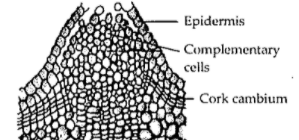
Given figures shows

A. Structure of lenticel
B. Hydathode showing gaseous vapour exchange
C. Fungus reproducing by spore formation
D. Algae reproducing by spore formation

Answer
458.7k+ views
Hint: It is usually found on woody plants which have vascular and cork cambium activity. In woody plants, they occur as rough, cor-like in young branches. It also has an important role in gas exchange.
Complete answer: The given figure shows the structure of a lenticel. A Lenticel is a porous tissue composed of cells having large intercellular spaces. It is usually found in the bark of woody stems, fruits of dicot flowering plants and on the surface of some fruits and tubers. It acts as a method of aeration in woody plants, in which the epidermis may be replaced by the suberized periderm or bark in which stomatal functions are replaced by lenticels. The formation of lenticels is linked to the growth and strength of the shoot and the internal moisture content of the tissue. Lenticels act as a medium for gaseous exchange and transpiration through loosely arranged thin-walled complementary cells. Complementary cells of lenticels are produced from phellogen. Phellogen is a ring of meristematic tissue formed from the outer parenchyma cells present in the cortex of dicot stems. Secondary cortex is known as phelloderm. These are thin-walled cells that arise from the inner side of the cork cambium. Phelloderm helps in the development of periderm. Cork cambium is a tissue found in the epidermis of many vascular plants. Its primary function is to produce cork which is a tough protective material found on the outer surfaces of the woody plants.
Hence, the correct answer is option A.
Note: Lenticels play an important role in gaseous exchange in plants. It promotes the exchange of carbon dioxide, oxygen and water vapour. They are found as raised circular, oval, or elongated areas on stems and roots.
Complete answer: The given figure shows the structure of a lenticel. A Lenticel is a porous tissue composed of cells having large intercellular spaces. It is usually found in the bark of woody stems, fruits of dicot flowering plants and on the surface of some fruits and tubers. It acts as a method of aeration in woody plants, in which the epidermis may be replaced by the suberized periderm or bark in which stomatal functions are replaced by lenticels. The formation of lenticels is linked to the growth and strength of the shoot and the internal moisture content of the tissue. Lenticels act as a medium for gaseous exchange and transpiration through loosely arranged thin-walled complementary cells. Complementary cells of lenticels are produced from phellogen. Phellogen is a ring of meristematic tissue formed from the outer parenchyma cells present in the cortex of dicot stems. Secondary cortex is known as phelloderm. These are thin-walled cells that arise from the inner side of the cork cambium. Phelloderm helps in the development of periderm. Cork cambium is a tissue found in the epidermis of many vascular plants. Its primary function is to produce cork which is a tough protective material found on the outer surfaces of the woody plants.
Hence, the correct answer is option A.
Note: Lenticels play an important role in gaseous exchange in plants. It promotes the exchange of carbon dioxide, oxygen and water vapour. They are found as raised circular, oval, or elongated areas on stems and roots.
Recently Updated Pages
Questions & Answers - Ask your doubts

Master Class 11 Accountancy: Engaging Questions & Answers for Success

Master Class 11 Science: Engaging Questions & Answers for Success

Full Form of IASDMIPSIFSIRSPOLICE class 7 social science CBSE

In case of conflict between fundamental rights of citizens class 7 social science CBSE

Can anyone list 10 advantages and disadvantages of friction

Trending doubts
10 examples of friction in our daily life

The correct order of melting point of 14th group elements class 11 chemistry CBSE

Difference Between Prokaryotic Cells and Eukaryotic Cells

One Metric ton is equal to kg A 10000 B 1000 C 100 class 11 physics CBSE

What is the specific heat capacity of ice water and class 11 physics CBSE

State and prove Bernoullis theorem class 11 physics CBSE




